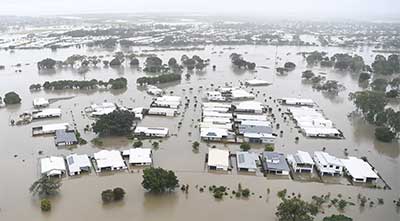Daily-current-affairs
/
23 Oct 2020
Flash Flood Guidance Services (FFGS) : Daily Current Affairs

Flash Flood Guidance Services (FFGS)
Why in NEWS ?
- The India Meteorological Department (IMD) on 23 rd October 2020, launched the South Asian
Flash Flood Guidance System (FFGS).
About
- It is aimed at helping disaster management teams and governments make timely
evacuation plans ahead of the actual event of flooding.
- India is leading a delegation of nations, including Bhutan, Sri Lanka, Bangladesh and
Nepal, in sharing hydrological and meteorological data towards preparing flash flood
forecasts.
- India’s National Disaster Management Authority and the Central Water Commission
have also partnered in this system.
Flash floods
- Flash floods are sudden surges in water levels during or following an intense spell of
rain, occuring in a short time duration over a localised area.
- The flood situation worsens in the presence of choked drainage lines or
encroachments obstructing the natural flow of water.
- This occurs in hilly and not too hilly regions and sloping lands where heavy rainfall
and thunderstorms or cloudbursts are common.
Causes of Flash floods
- A flash flood is a rapid inundation of geomorphically low-lying areas: washes, rivers,
dry lakes and basins. It may be caused by heavy rain associated with a severe
thunderstorm, hurricane, tropical storm, or meltwater from ice or snow flowing over
ice sheets or snowfields.
- However, floods are not always caused by heavy rainfall. Flash Floods can be caused
by a number of things, but is most often due to extremely heavy rainfall from
thunderstorms.
- Flash Floods can occur due to Dam or Levee Breaks, and/or Mudslides (Debris Flow).
- In areas on or near volcanoes, flash floods have also occurred after eruptions, when
glaciers have been melted by the intense heat.
- The intensity of the rainfall, the location and distribution of the rainfall, the land use
and topography, vegetation types and growth/density, soil type, and soil water-
content all determine just how quickly the Flash Flooding may occur, and influence
where it may occur.
Recent examples flash floods in India
- In the latest incident involving flash floods, Hyderabad city was battered by heavy
rain, resulting in massive flooding which inundated roads, earlier this month. As the
city recorded 191 mm of rain within the span of a few hours, the heaviest in 97 years
recorded in October, several water bodies in Telangana’s capital breached danger
levels, worsening the overall flood situation. Nearly 70 people lost their lives and
many hundreds were displaced from their homes.
- In the following days, Sangli, Solapur and Pune districts in Maharashtra also faced
similar intense rain and flooding that claimed over 30 lives and damaged standing
kharif crop.
- 2014 and 2018: Srinagar, Jammu & Kashmir.
- 2017: Uttarakhand, West Bengal, Bihar and multiple states in the North East.
Flash Flood Guidance System
- The model will provide forecasts by computing likelihood of rainfall and soil moisture
levels to warn of possible floods.
- It will carry out forecasts by using combination of satellite mapping and ground-
based observation.
- It will be customized weather model, originally developed by US and donated to
WMO to warn about flash floods at least six hours in advance.
- A dedicated FFGS centre will be established in New Delhi, where weather modelling
and analysis of rainfall data observations from member countries will be done.
- Based on the rainfall and potential flooding scenario, flash flood warnings will be
issued to respective nations. Flash flood threat warning will be issued six hours in
advance, whereas flood risk warning will be issued 24 hours in advance. Warnings
about watershed level will be issued 12 hours in advance
Need
- Data from World Meteorological Organisation (WMO) suggest that across the world,
about 5,000 people die annually due to flash floods. Despite such high mortality,
there is no robust forecasting or warning system for flash floods.
- The heads of meteorological and hydrological departments of the WMO and the four
South Asian countries put forth their views and the urgent need for such a warning
system, which has been developed by US-based Hydrologic Research Centre.
- Secretary of the Ministry of Earth Sciences (MoES), highlighted that the frequency of
extreme rainfall events has increased due to climate change and South Asia is highly
prone to flash floods.
- As much as 80 per cent of natural disasters experienced in all these South Asian
countries is contributed by erratic weather. Among these, flash floods lead to heavy
loss of lives and to property.
- In addition, the impact over South Asia increases many times due to varying
topography — mountains, oceans, Eastern and Western Ghats, Myanmar hills and
others.







